There’s a unique and enchanting appeal to houseplants with purple leaves. The hue adds a stunning pop of color, making these indoor plants a favorite choice for those wishing to bring a vibrant touch to their indoor space. Purple is associated with royalty, luxury, and ambition, making these plants an elegant addition to any home or office setting.
If you’re interested in bringing more vibrant colors into your garden beyond just indoor plants, consider exploring native edible plants that thrive in your local environment. Check out this guide on transforming your garden with native edible plants.
Types of Purple Houseplants
Discover our favorite purple houseplants that can elevate any indoor space. Each plant with purple leaves is unique, displaying a stunning interplay of purple and green hues. From flowering plants to leafy wonders, this guide showcases the diversity and beauty of purple houseplants.
Purple Passion (Gynura aurantiaca)

The Purple Passion plant is famous for its striking purple-green leaves with soft, velvety hairs. It’s a perfect choice if you’re looking for a plant that will stand out in your indoor garden due to its deep purple foliage and exciting texture. The care for this beautiful purple houseplant includes providing indirect sunlight and regular watering to keep the soil moist.
To keep your Purple Passion plant thriving, maintaining the right humidity is key. A small indoor humidifier can help prevent dryness and keep your plants happy. Check out this highly-rated plant humidifier on Amazon.
Purple Shamrock (Oxalis triangularis)

This beautiful purple houseplant, also known as Purple Shamrock, boasts striking, heart-shaped leaves that grow in trios, folding up at night like a prayer plant. With the proper care, it can produce delicate white flowers. The Purple Shamrock requires indirect sunlight and slightly moist soil.
If you’re growing plants indoors and outdoors, understanding your local climate is crucial. North Carolina gardeners, for example, can determine the best planting times and conditions using this guide on the state’s growing zones.
Persian Shield (Strobilanthes dyerianus)
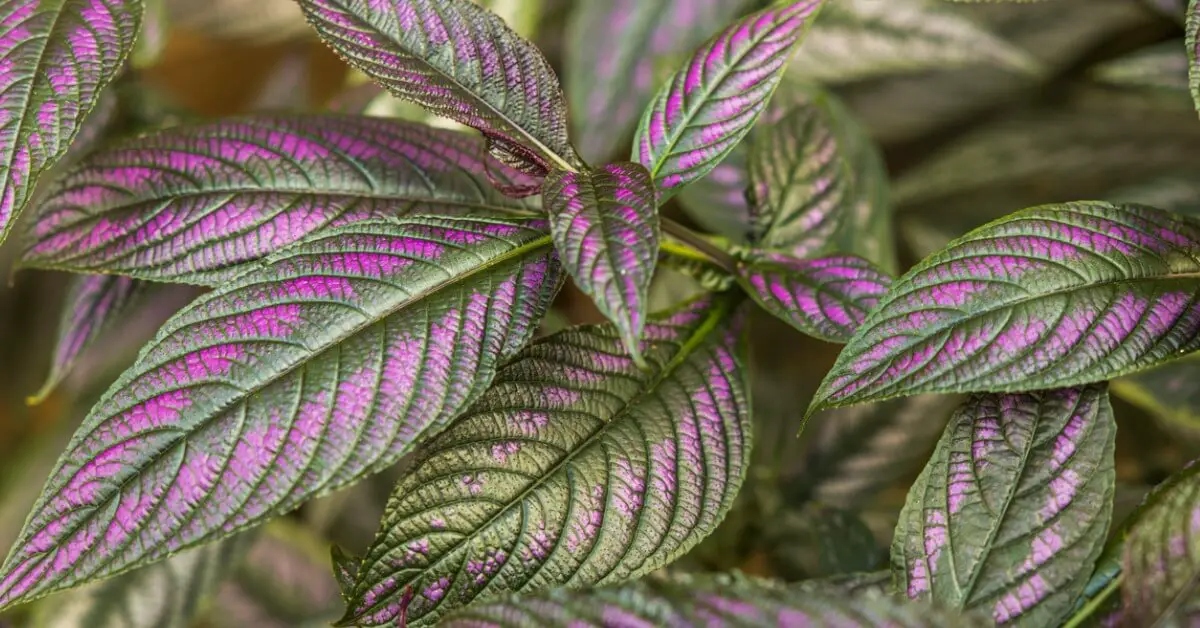
The Persian Shield plant is a beautiful tropical plant with lance-shaped leaves boasting purple, silver, and green shades. Its shimmering leaves and vibrant purple color make it a standout among houseplants. Persian Shield plants prefer bright, indirect light and high humidity.
Purple Waffle Plant (Hemigraphis’ Exotica’)

The Purple Waffle Plant is an unusual purple house plant with a striking appearance. Its dark green leaves have deep purple undersides, adding vibrant color to your indoor space. This plant also prefers a humid environment and bright, indirect sunlight.
Ti Plant (Cordyline fruticosa)
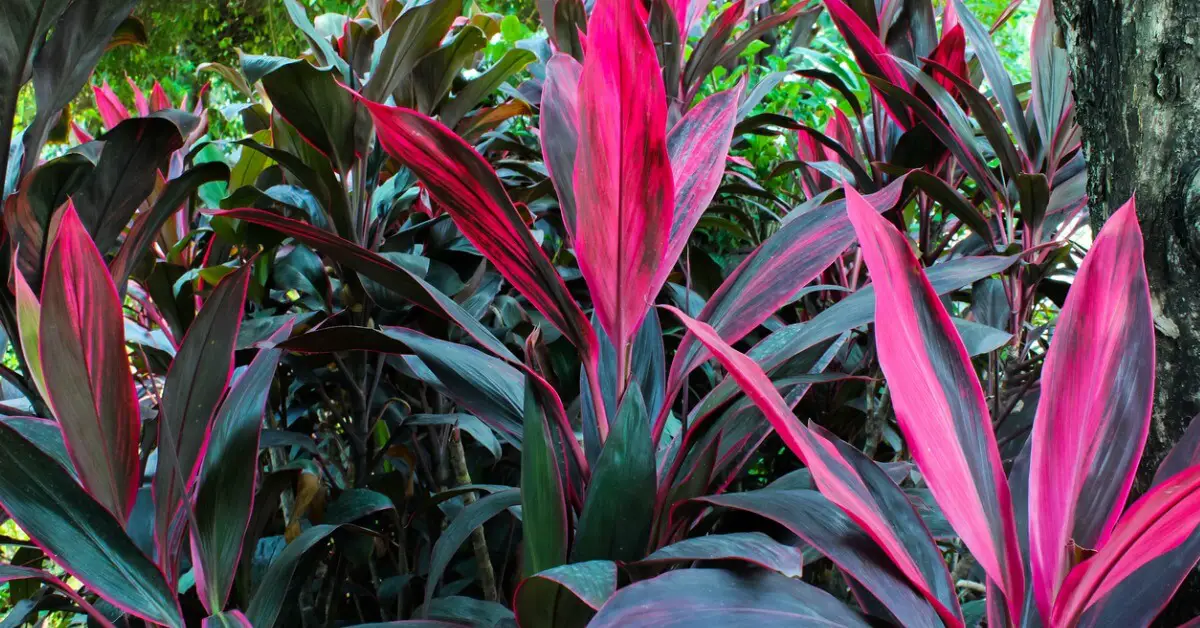
The Ti Plant, another popular houseplant, is known for its dramatic, dark purple leaves that range in color from reddish-purple to a deep, glossy burgundy. The plant also produces fragrant, pale pink flowers that add to its charm. The Ti Plant prefers bright, indirect sunlight and well-draining soil.
Purple Heart (Tradescantia pallida)
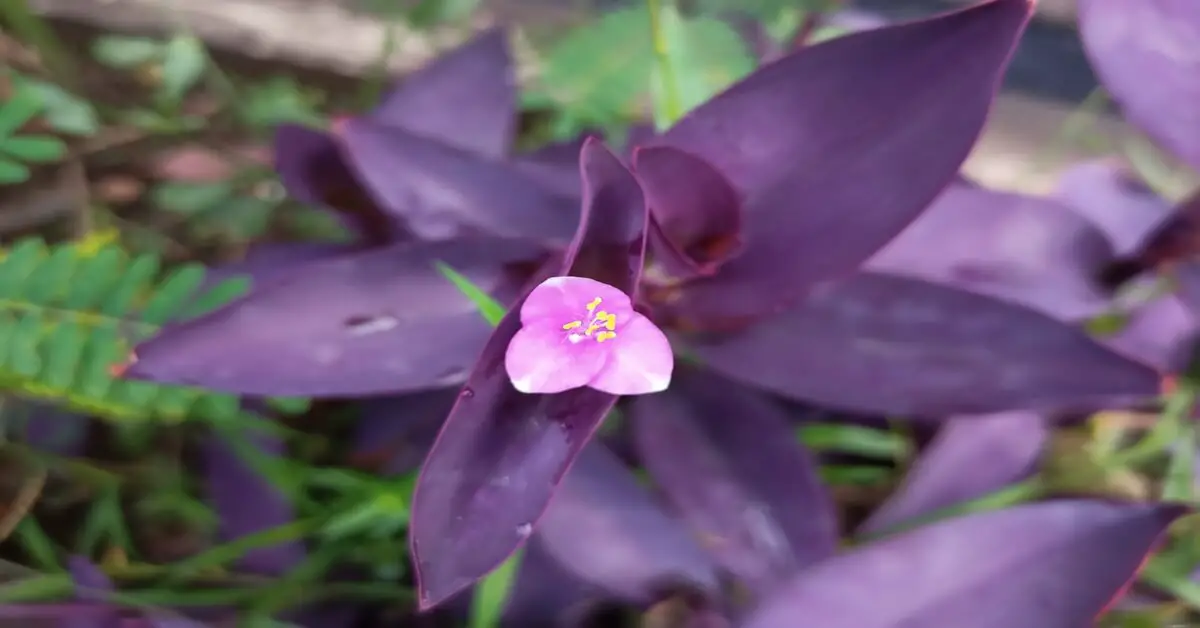
The Purple Heart is one of the most popular houseplants with purple leaves. Native to eastern Mexico, this plant distinguishes itself with its trailing purple stems and heart-shaped leaves, ranging from deep purple to metallic violet. It’s a dynamic plant, creating a cascading effect that is particularly attractive in hanging pots.
The Purple Heart plant also features small, three-petaled pink flowers that bloom periodically throughout the year. This plant thrives best in well-drained soil and indirect sunlight. Remember, though it’s a robust plant, it requires regular care to maintain its vibrant color and prevent the stem from becoming leggy.
Alocasia Purple Sword
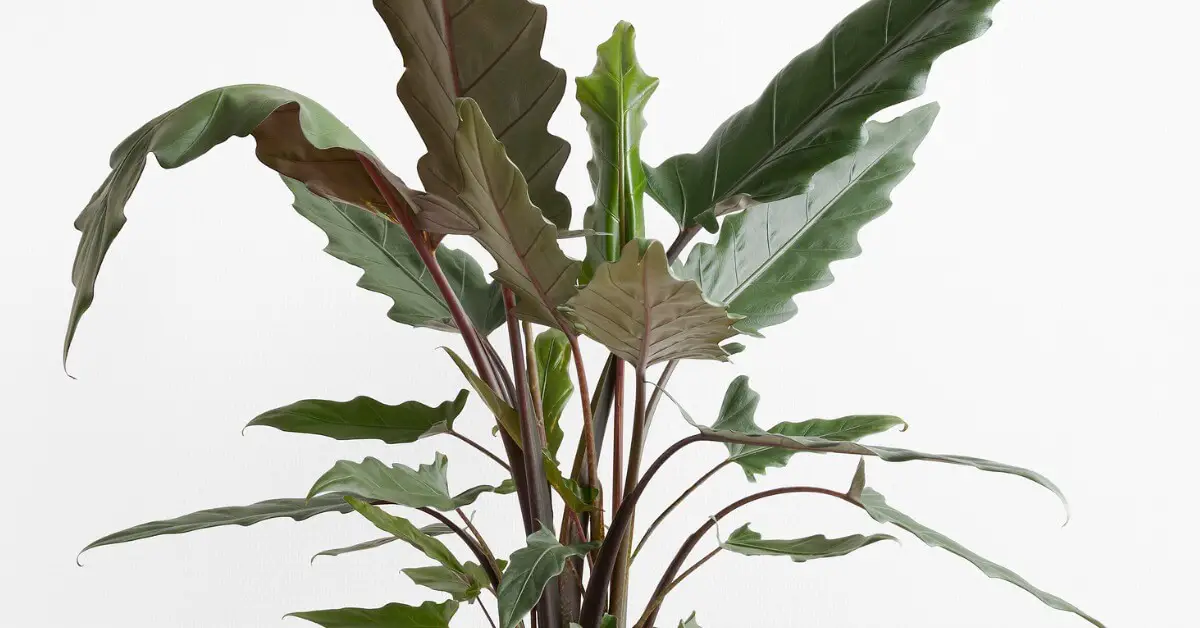
The Alocasia Purple Sword is a tropical plant that will catch the eye. It features long, sword-like green and purple leaves that appear as if painted with a brush. The striking contrast of the bright green top and rich purple underside gives this indoor plant a unique visual appeal.
As part of your plant care routine, ensure it receives good indirect sunlight and moist soil.
Purple Orchid (Orchis mascula)
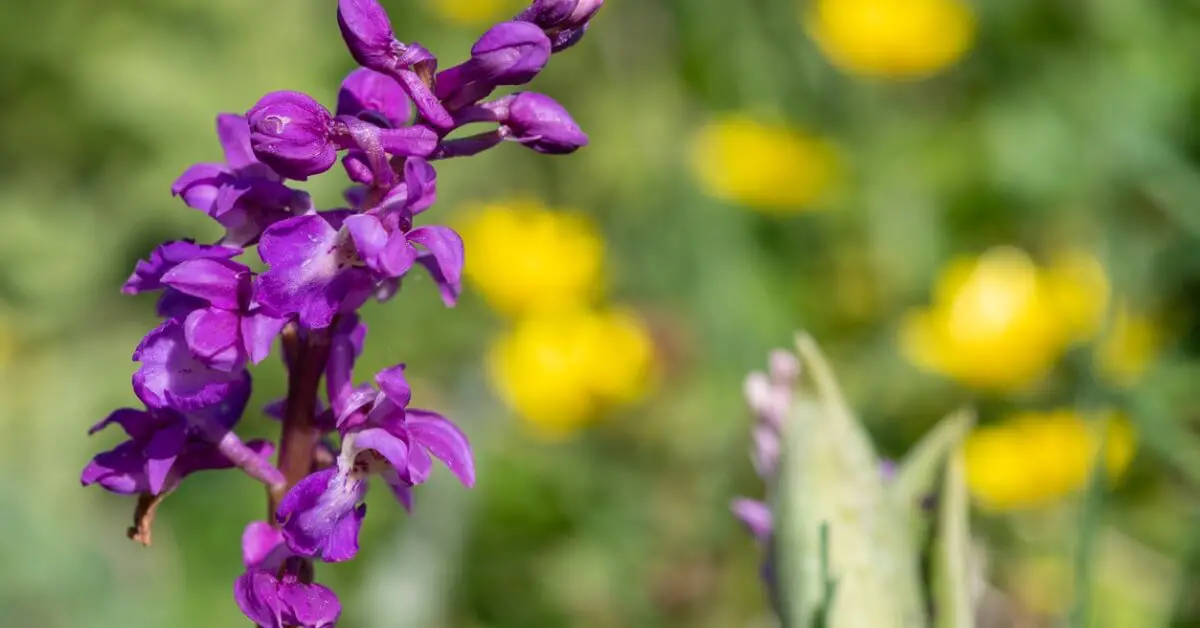
The Purple Orchid, or Orchis mascula, is a rare and beautiful purple flower that can bring a touch of elegance to your indoor garden. It boasts a vibrant stem full of deep purple flowers, making it a stunning centerpiece. While primarily green, the leaves carry purple spots, adding to their allure.
Caring for this purple indoor plant can be delicate; it requires a fine balance of indirect sunlight, humidity, and well-draining soil to flourish. It’s important to avoid overwatering and ensure it gets enough airflow to prevent disease.
Orchids can be delicate and require proper airflow to stay healthy. A gentle plant fan can help ensure air circulation and prevent mold. Here’s a great option for a fan on Amazon.
Ruby’s Necklace (Othonna capensis)
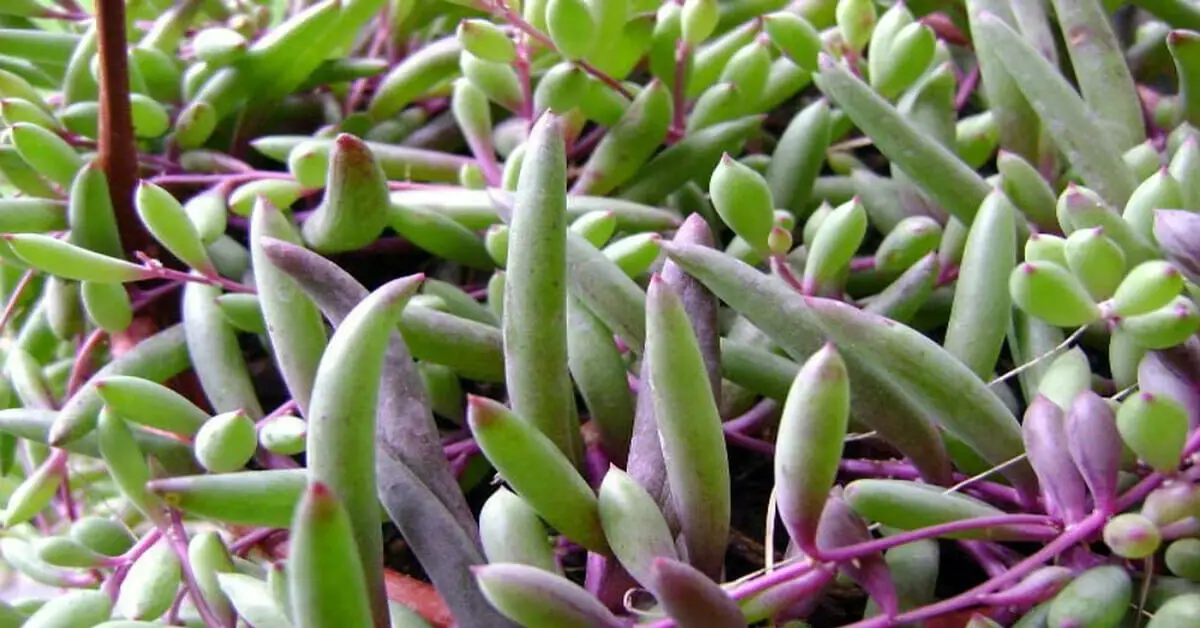
Finally, there’s Ruby’s Necklace, also known as Othonna capensis. This succulent plant has long, bean-like leaves that hang over the sides of its pot, similar to a string of beads. The leaves, green at the core, transition into a stunning deep purple towards the edge, resembling a jeweled necklace.
What makes this houseplant even more remarkable is the yellow daisy-like flowers that bloom from long, slender purple stems. This plant is relatively easy to care for, requiring a well-draining pot, plenty of sunlight, and infrequent watering, as with most succulents.
Care for Purple Leaf Houseplants
Care for your purple houseplants involves several key factors. First, most purple-leaf plants require bright, indirect sunlight to maintain their vibrant color. Insufficient light can lead to fading or greening of the purple hue.
Secondly, soil moisture is critical, as most purple houseplants prefer slightly moist soil. However, overwatering can lead to root rot, so allowing the soil to dry out somewhat between waterings is essential.
High humidity often benefits these plants, given their tropical origins. You can increase humidity by grouping plants, placing them on a tray of pebbles with water, or using a room humidifier.
Lastly, a balanced, water-soluble fertilizer applied every two weeks during the growing season usually suffice for plant food.
For those who want to expand beyond houseplants, container gardening can be a great way to grow vibrant plants in limited spaces. Learn more about container gardening for a productive harvest here.
If you want to ensure your plants get the nutrients they need, using a balanced, water-soluble fertilizer is essential. This top-rated indoor plant fertilizer from Amazon can help keep your purple houseplants vibrant and healthy.
Conclusion: Bringing Purple Into Your Indoor Space
Incorporating houseplants with purple leaves is a fantastic way to add a pop of color and create a refreshing aesthetic in your indoor space. These beautiful purple houseplants are visually pleasing and work as natural air purifiers.
Their stunning green foliage and different shades of purple make for a captivating display. As we’ve seen, indoor plants with purple leaves come in various species, each with its unique charm and care requirements.

